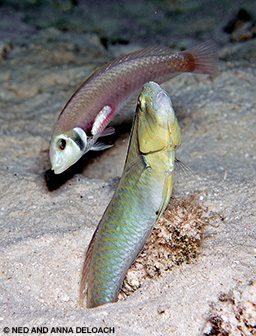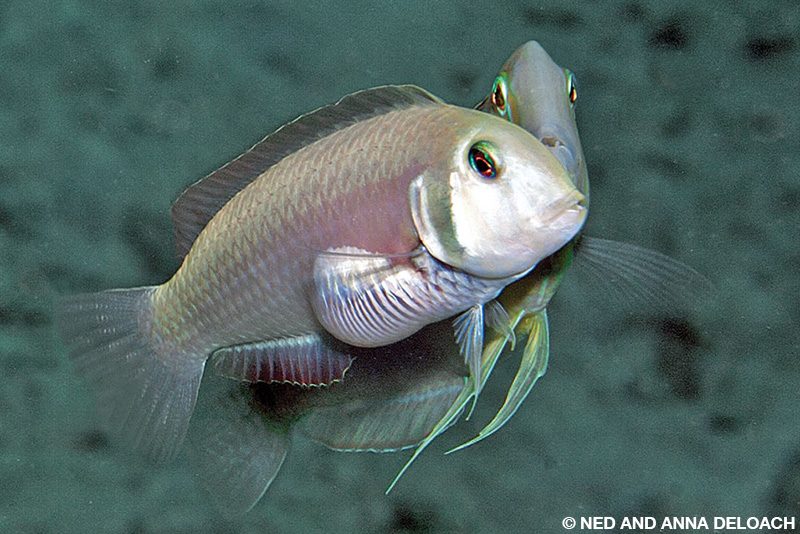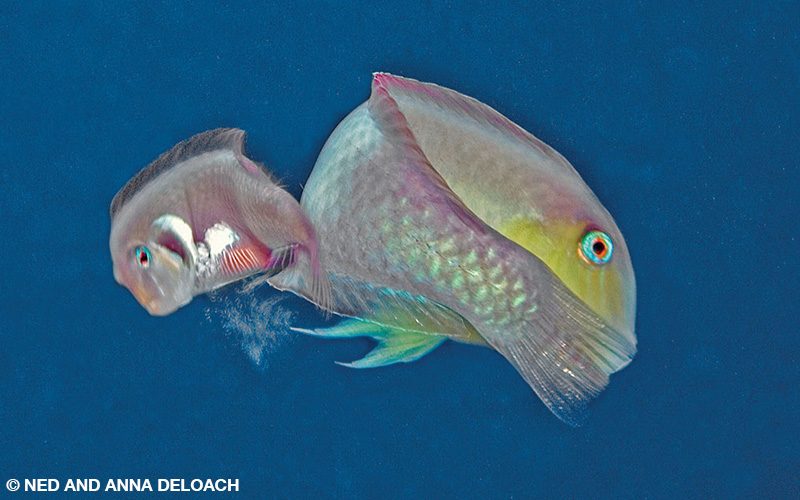When fish flock to reefs for shelter and food, it creates a never-ending struggle for resources. Even though the sand surrounding the coral fortresses harbors a smorgasbord of tasty treats, it would be death-defying for small reef fishes to venture so far from shelter. As expected, over the ages a contingent of fishes has evolved some nifty adaptations to take advantage of the untapped bounty.
Burrow building — practiced by jawfish, tilefish and a scattering of gobies — is nature’s go-to solution for life on the sand. Three small wrasses, however, including rosy razorfish (our most recent fish of interest), have taken an alternate route to survival: By developing heads as hard and sharp as cleavers, they can power dive beneath the sand when threatened. Minutes later, after the coast clears, the slender 5-inch fish slip out of the sand and calmly go about their business picking plankton from the currents overhead.
It’s the afternoon affairs of the hatchet-headed rosies that Anna and I have returned to Bonaire to investigate. On our first day back on the island, we head straight for the sand flats north of Town Pier to see what has changed since our visit a year ago. To our amazement, we find the local population of rosies has ballooned from a dozen or so to more than a hundred.

After a bit of sleuthing, we learn that the rosies’ colony — an ever-morphing mosaic of contiguous territories — spreads across several hundred square feet of featureless terrain. The prime real estate consists of 4-foot territories near the center, each dominated by a large breeding male along with three to five smaller females with which he attempts to exclusively mate. A cabal of eager young bachelors relegated to the outskirts, however, has other ideas.
Rosies, like most wrasses, are protogynous hermaphrodites that are born as females into a hierarchical system where size and sex mean everything. Later, when growth and social status dictate, some females change into males — the pinnacle of reproductive prosperity in fishdom. This life-changing transformation initiates a growth spurt and later bestows the yellow-green coats of male maturity. Such a competitive social system fosters bickering, so throughout the day females nip at underlings, while dominant males vigilantly guard invisible borders from encroaching males that are primed and ready to try to usurp a female or two.

Even with all the dissension, colony members depend on each other for survival. When predators prowl, a fright reaction spreads throughout the colony like a whisper. Fish drop to the bottom, list to their sides and take on camouflage coats. If the danger persists, they dive into personal patches of sand kept clear of rocks and debris for such occasions. On one visit, we watch a cloud of feeding rosies hit their manicured patches like hailstones as a band of jacks streak past. Minutes later, heads pop up, pivoting like periscopes. Taking cues from neighbors, first one, then two, then dozens wiggle free from the bottom.
One morning from a distance we see a large yellowtail snapper circling high above the colony. A hundred sets of eyes, along with ours, track the predator until it fades from view. The snapper soon returns, makes two low passes, vanishes, returns, circles twice, cuts high across the colony and disappears once again. The threat lurks for 10 minutes until the snapper strikes from out of the blue with the speed of a missile, taking out one of the colony’s largest males with a blow that leaves the fish dead on the sand. The loss of such a high-ranking colleague creates a power vacuum, setting into motion a time-honored struggle for dominance far too nuanced for our eyes to decipher.

What we can appreciate are the rosies’ daily courtship and spawning rituals, which took place that afternoon as if nothing had happened. Around 2 p.m. the rosies fall under a spell. As they are preoccupied, we can get in close, right up to the edge of the action. Within a few feet of where we kneel, giddy males set off to court each of their females in turn, caressing their flanks with flowing fins as the aloof females repeatedly shy away. At the height of their quest, suitors strike ridged, head-down poses with their colors blazing before disappearing beneath the sand. It takes nearly an hour of caressing, cajoling and plunging before the first egg-swollen female rises off the bottom. A male streaks to her side, and the pair curls together and spirals up a foot or so, where they release a pea-sized puff of gametes. Across the colony other couples follow suit.
Afterward, the rosies become increasingly lethargic, until one by one they bed down for the night by diving into the safety of the sand as the sun sets.
Explore More
Watch this video to learn more about rosy razorfish.
© Alert Diver — Q3 2019